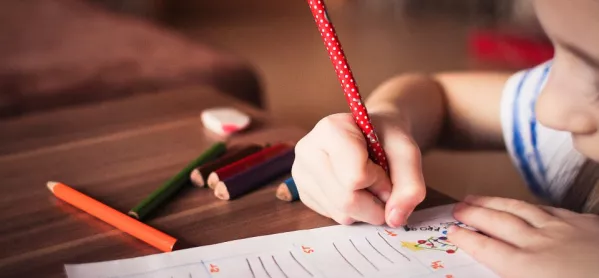Why we stopped teaching cursive writing in Reception
Share
Why we stopped teaching cursive writing in Reception
In the early years, we have a sensible and appropriate approach to teaching young children in the UK - except when it comes to writing.
In this area, we seem to ignore the principles of the early years foundation stage and adopt a practice of teaching that goes against what is developmentally appropriate and engaging for young children.
I am talking, of course, about the dreaded cursive script.
Quick read: EYFS: How to maximise the potential of snack time
Quick listen: How to teach handwriting: a comprehensive guide
Want to know more? SEND: Why your school should sign up to BSL
It is common for schools to teach children to form fully cursive script using both “lead in” strokes and “exit” strokes, as well as joining some letters.
Unfortunately, I have had to suffer the teaching of this awful “spaghetti-yeti” writing for many years with the Reception classes that I have taught.
Worse still, the children have had to suffer it. In my experience, it is the biggest killer of enjoyment for writing.
I do not support the introduction of cursive handwriting in Reception. I have strong feelings about this and I know from many conversations that I am not alone in my view.
If writing is already a complex perceptual motor skill, why make it even harder by requiring letter-joining from children who are barely beginning to pick up a pencil?
The cost is great because it significantly affects children’s motivation to write.
The curse of the cursive
We had a long and honest discussion about this at my school recently and came to the conclusion that an early introduction does not benefit the children and isn’t working.
Here are some problems that we typically experience:
- Children firstly printing the letter and then adding on “sticks” to lead in /exit afterwards.
- Children having more difficulty reading back their writing (a key aspect of the early learning goals).
- Children joining words together and missing out finger spaces.
- Key stage 1 teachers growing frustrated at children for not forming cursive letters properly.
- Children paying poor attention to the content of their writing because they are so busy concentrating on forming letters.
- Children becoming frustrated as they lack the necessary fine motor skills, particularly boys.
- Children saying that they don’t want to write because it is too challenging.
- Parents struggling to help at home because they also find cursive writing difficult.
Are we well informed?
I have found a wealth of information to support my view from both handwriting specialists (Pam Hulme and Angela Webb) and early years teachers. Interestingly, these views are not usually the ones considered when it comes to decision-making on handwriting policy.
Reception teachers, who can draw on their knowledge and experience of children’s typical skills at this age, should be heard on this issue.
These professionals point out some key messages when it comes to considering the when and if of adopting the approach.
Complex coordination
Handwriting is complex. It requires the coordination of multiple skills on a physical, perceptive and cognitive level. Too few children will have developed maturity with these skills at age 4.
Take the use of diagonal strokes, for example, which children will only begin to master at about age 4 and a half. This has implications for our summer-born children.
Pam Hulme points out that if we are hoping to see the benefits later on, we risk being disappointed; often, premature letter-joining can result in a legacy of problems that is difficult to reverse at a later stage.
We should rightly question the common belief that the continuous “flow” of the cursive is faster and offers greater fluency, when experts argue that this is not necessarily true. It is also unlikely to be achieved with our youngest children.
Capacity for concentration
We must also consider that beginner writers need to work more slowly and use their capacity for concentration on the letter-sound correspondence rather the effort of joining.
As it is common for children to have already learned to print some letters before starting school, they are relearning at a crucial point, which can be confusing.
The outcome of this research and discussion in my school has been to make huge changes to our practice: we have decided not to teach cursive writing in Reception this academic year, at the end of which we will review the impact.
I’m confident this will be a positive change, but I am open to see what happens. Watch this space…
Helen Pinnington is early years foundation lead at St Thomas More’s Catholic Primary School in Bedhampton, Hampshire




